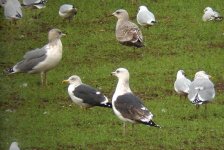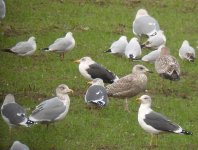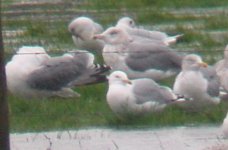Increased tipping activity at this site coincided with a noticeable increase in numbers of larger gulls, last winter, so Carl Baggott and I decided to spend some time there - especially to see if we might locate something like a Caspian or Yellow-legged Gull!
Indeed we had both species, eventually, but what we found was a need to raise our LWHG ID up a few notches in order to understand just what species/races were present - you shouldn't claim a rarity until you have a reasonable knowledge of the commoner species (well that's what they tell us!).
On checking various websites, BB papers, etc. one thing became clear - these gulls are very variable and you have to keep an open mind on them plumage-wise and size-wise. Males are bigger than females and argentatus Herring Gulls are bigger than argenteus so with this in mind the comparitively small size of the Great Black-back in the first shot becomes much clearer.
One of the ways to 'test' our ID skills was to take various flock-shots and see if we could ID everything that was showing clearly.
Wiith this in mind my views are the same as anyone else's here and there's obviously a broad agreement on the birds involved.
In shot 1 the left-hand bird must be a large male argentatus with the small, pale GBB in the foreground being a female and I would think a 4CY with that amount of brown. The RH bird is argenteus being paler with less streaking on the head than argentatus. I think that all the young 2CY birds in both shots were argentatus mainly based on the fact that all the young birds present (not just in the shots) seemed big enough for that race - none looked noticeably small against the adult birds (although the RH one in the second photo is hard to call). The second left bird is, I think, an intermedius Lesser Black-back - it was distinctly darker than any graellsii present.
In shot 2 there is a triangle of graellsii's at the front with what I believe is a female argentatus as the second bird from the left - basically, I think the head streaking is too heavy for argenteus one of which is top right showing less streaking and paler mantle. The most noticeable bird here, (and the reason that it's in middle of the photo) is the intermedius LBB. This really did stand out as being very dark (darker than the bird in shot 1) and I obviously had hopes of a Baltic Gull with it! However, all the info or photos that I could find would suggest that fuscus should have a white head at this time. This bird has just too much streaking, I think, but it was a good try none the less!
These are my personal opinions and if anyone has any other ideas I'd be pleased to hear them. It would be interesting to know, for instance, if it's possible to seperate juv argenteus and argentatus where you haven't anything for size-comparison.
As another interesting male/female size-comparison I've attached below a shot (taken from about 1/4 mile away with the digital-zoom full on in the camera!) of the Caspian Gull, which was a small female with a huge 'buck' argentatus Herring Gull behind.
The high viewpoint coupled with the fact that the Caspian is squatting behind some grass and is not quite full sideways-on exaggerates the size difference somewhat but it still demonstrates the need to keep an open mind on these birds.
Adey







